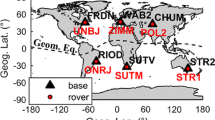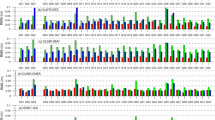Abstract
Ionospheric observables based on Global Navigation Satellite System can be obtained by a variety of approaches. The most widely used one is the geometry-free combination of carrier-phase smoothed code measurements. This method, however, introduces leveling errors that substantially degrade the performance of ionospheric modeling and bias estimation. To reduce leveling errors, precise point positioning (PPP) model is preferred for obtaining the ionospheric observables. We aim to investigate whether the ionospheric observables obtained from three different PPP models are consistent and how the PPP-based ionospheric observables relates to the smoothed code method. The paper begins by formulating the ionospheric observables. We then explain the statistical evaluation methods used for analyzing the bias terms derived from these methods and assessing the leveling errors from the carrier-phase smoothed code method. Numerical analysis is then conducted to compare the bias terms in the ionospheric observables and evaluate the leveling errors. The ionospheric observables based on the three PPP models show strong consistency. Compared to leveling errors in the carrier-phase smoothed code method, the leveling errors using the uncombined PPP model are significantly reduced up to five times.







Similar content being viewed by others
References
Abdel-salam MA-T (2005) Precise point positioning using un-differenced code and carrier phase observations. University of Calgary, Calgary
Banville S, Zhang W, Ghoddousi-Fard R, Langley RB (2012) Ionospheric monitoring using “integer-levelled” observations. In: Proceedings of ION GNSS 2012, Nashville, 17–21 Sept 2012. Institute of Navigation, pp 2692–2701
Ciraolo L, Azpilicueta F, Brunini C, Meza A, Radicella S (2007) Calibration errors on experimental slant total electron content (TEC) determined with GPS. J Geod 81(2):111–120
Coster A, Williams J, Weatherwax A, Rideout W, Herne D (2013) Accuracy of GPS total electron content: GPS receiver bias temperature dependence. Radio Sci 48(2):190–196
Dach R, Hugentobler U, Fridez P, Meindl M (2015) Bernese GPS software version 5.2. Astronomical Institute, University of Bern, Bern
Feltens J, Schaer S (1998) IGS products for the ionosphere. In: Proceedings of the 1998 IGS analysis center workshop, Darmstadt
Hernandez-Pajares M, Aragon-Angel A, Defraigne P, Bergeot N, Prieto-Cerdeira R, Garcia-Rigo A (2014) Distribution and mitigation of higher-order ionospheric effects on precise GNSS processing. J Geophys Res Solid Earth 119(4):3823–3837
Héroux P, Kouba J (2001) GPS precise point positioning using IGS orbit products. Phys Chem Earth Part A 26(6):573–578
Komjathy A, Sparks L, Wilson BD, Mannucci AJ (2005) Automated daily processing of more than 1000 ground-based GPS receivers for studying intense ionospheric storms. Radio Sci 40(6):RS6006
Li Z, Yuan Y, Li H, Ou J, Huo X (2012) Two-step method for the determination of the differential code biases of COMPASS satellites. J Geod 86(11):1059–1076
Li M, Yuan Y, Wang N, Li Z, Li Y, Huo X (2017) Estimation and analysis of Galileo differential code biases. J Geod 91(3):279–293
Montenbruck O, Hauschild A, Steigenberger P (2014) Differential code bias estimation using multi-GNSS observations and global ionosphere maps. Navigation 61(3):191–201
Petit G, Luzum B (2010) IERS conventions. Verlag des Bundesamts für Kartographie und Geodäsie, Frankfurt am Main
Ray J, Senior K (2005) Geodetic techniques for time and frequency comparisons using GPS phase and code measurements. Metrologia 42(4):215
Rovira-Garcia A, Juan JM, Sanz J, Gonzalez-Casado G (2015) A Worldwide ionospheric model for fast precise point positioning. IEEE Trans Geosci Remote Sens 53(8):4596–4604
Sanz J, Miguel Juan J, Rovira-Garcia A, González-Casado G (2017) GPS differential code biases determination: methodology and analysis. GPS Solut 21(4):1549–1561
Sardón E, Zarraoa N (1997) Estimation of total electron content using GPS data: how stable are the differential satellite and receiver instrumental biases? Radio Sci 32(5):1899–1910
Wang N, Yuan Y, Li Z, Montenbruck O, Tan B (2016) Determination of differential code biases with multi-GNSS observations. J Geod 90(3):209–228
Xiang Y, Yuan Y, Li Z, Wang N (2015) Analysis and validation of different global ionospheric maps (GIMs) over China. Adv Space Res 55(1):199–210
Xiang Y, Gao Y, Shi J, Xu C (2017) Carrier phase-based ionospheric observables using PPP models. Geod Geodyn 8(1):17–23
Zhang B (2016) Three methods to retrieve slant total electron content measurements from ground-based GPS receivers and performance assessment. Radio Sci 51(7):972–988
Zhang B, Teunissen P (2016) Zero-baseline analysis of GPS/BeiDou/Galileo between-receiver differential code biases (BR-DCBs): time-wise retrieval and preliminary characterization. Navigation 63(2):181–191
Zhang B, Ou J, Yuan Y, Li Z (2012) Extraction of line-of-sight ionospheric observables from GPS data using precise point positioning. Sci China Earth Sci 55(11):1919–1928
Zhang B, Teunissen PJ, Yuan Y (2017) On the short-term temporal variations of GNSS receiver differential phase biases. J Geod 91(5):563–572
Zhong J, Lei J, Dou X, Yue X (2016) Is the long-term variation of the estimated GPS differential code biases associated with ionospheric variability? GPS Solut 20(3):313–319
Acknowledgements
Data retrieved from the International GNSS Service (IGS) and products downloaded from Crustal Dynamics Data Information System and the Center for Orbit Determination in Europe (CODE) are both gratefully acknowledged. We also thank the Chinese Scholarship Council for scholarship assistance. This work has also been supported by the National Natural Science Foundation of China (Grant No. 41504027).
Author information
Authors and Affiliations
Corresponding author
Rights and permissions
About this article
Cite this article
Xiang, Y., Gao, Y., Shi, J. et al. Consistency and analysis of ionospheric observables obtained from three precise point positioning models. J Geod 93, 1161–1170 (2019). https://doi.org/10.1007/s00190-019-01233-1
Received:
Accepted:
Published:
Issue Date:
DOI: https://doi.org/10.1007/s00190-019-01233-1




